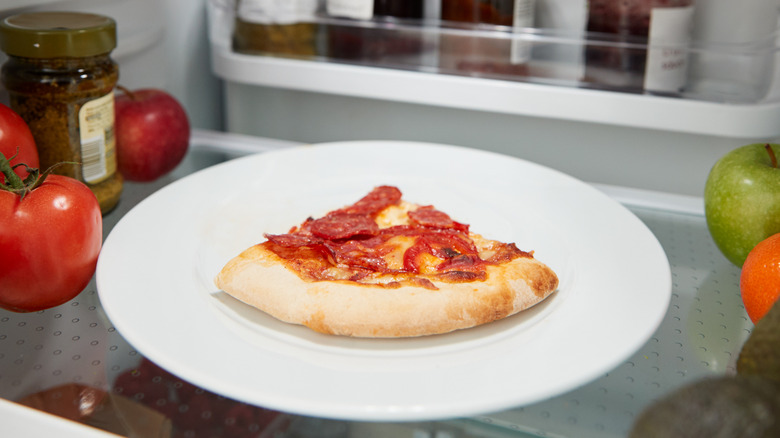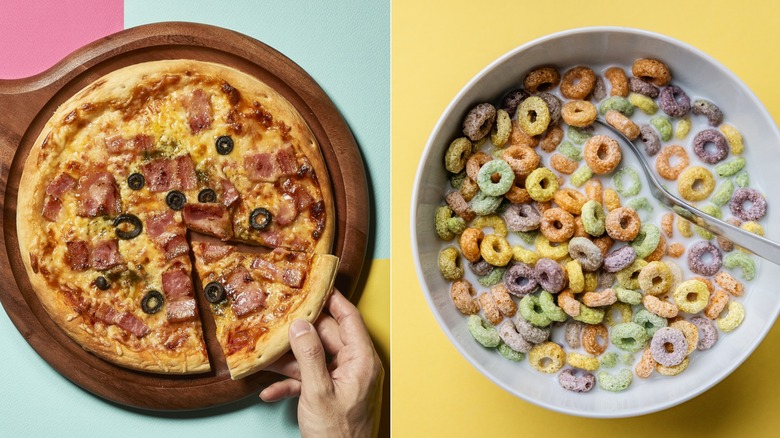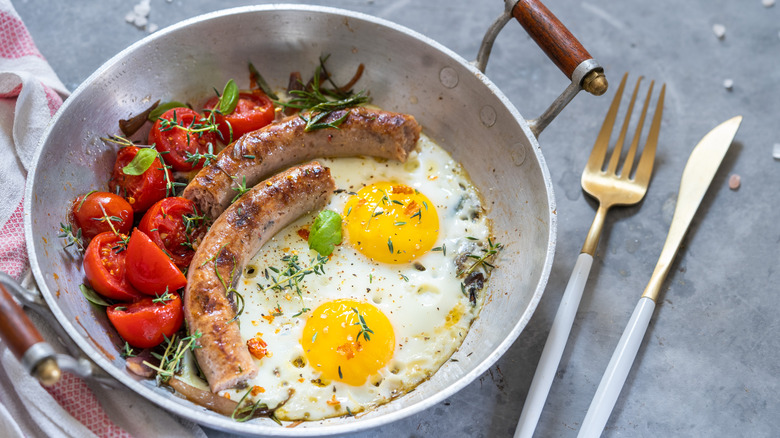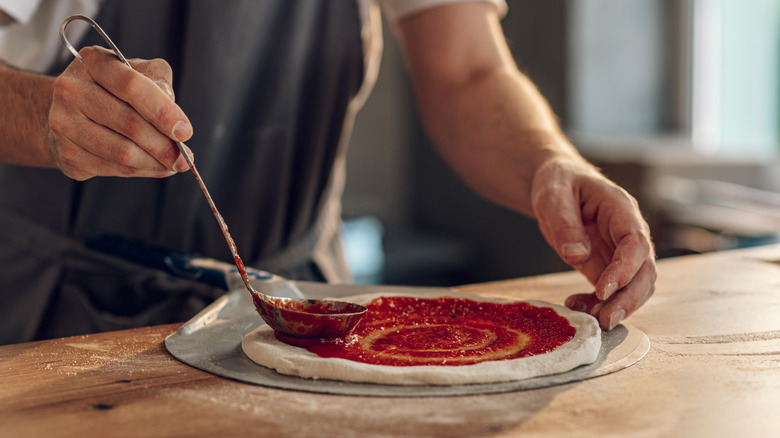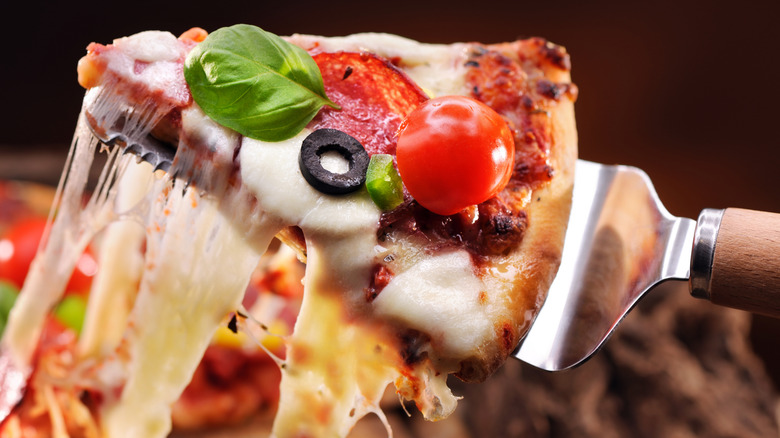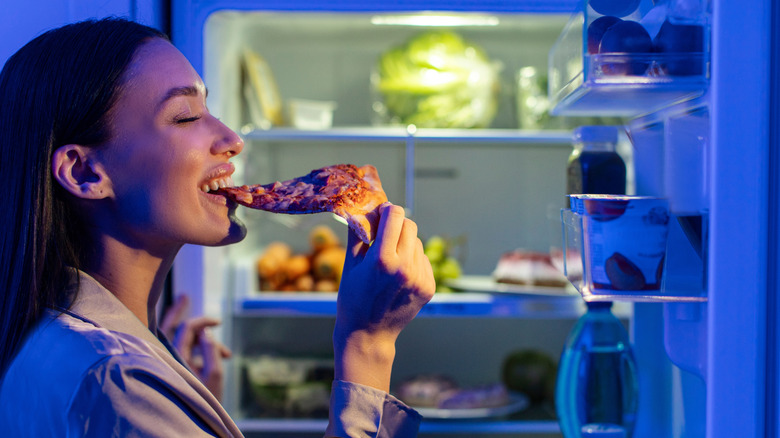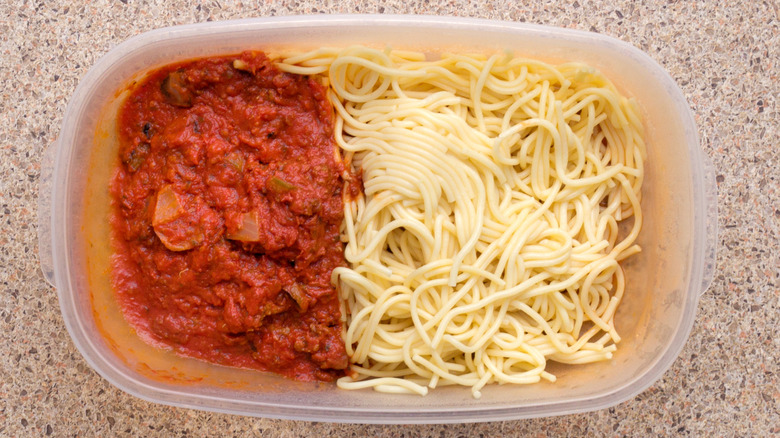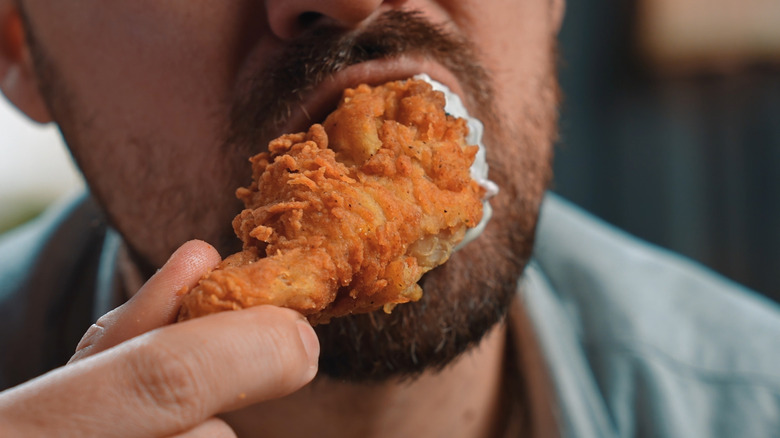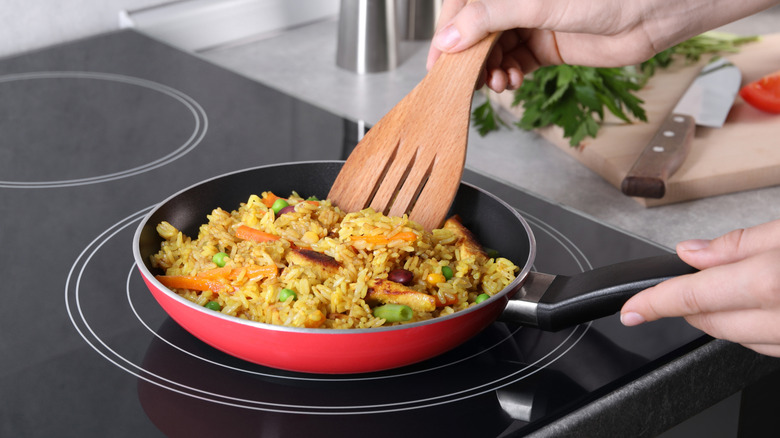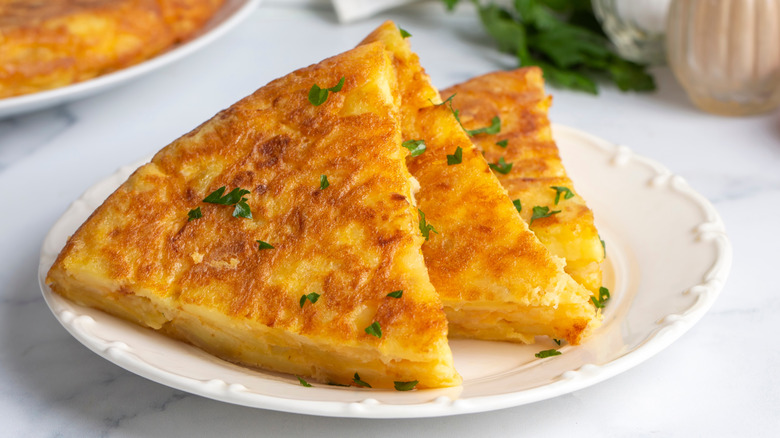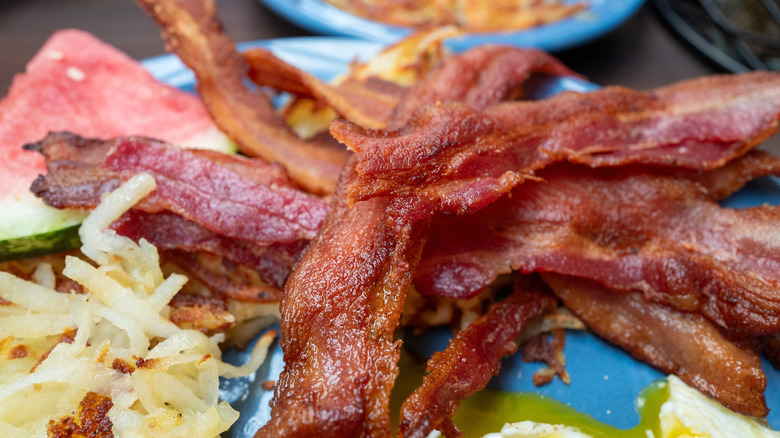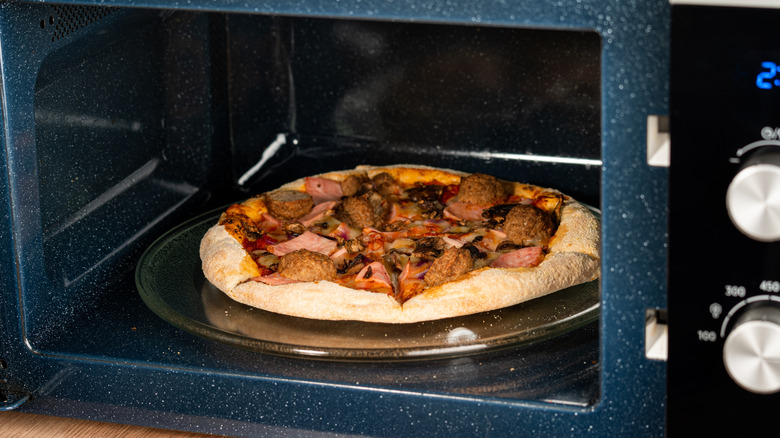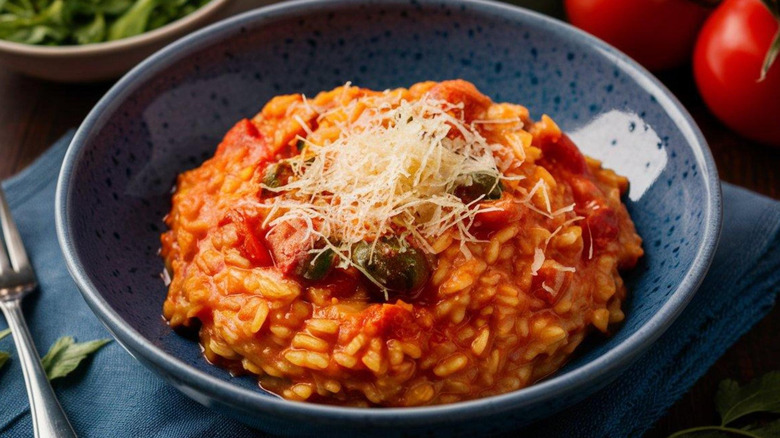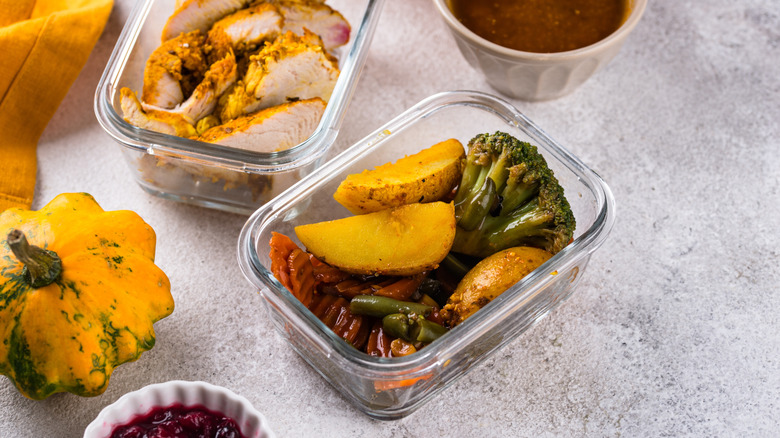Here's Why Cold Pizza Tastes So Good - And More Leftovers These Chefs Love For Breakfast
What's not to love about a piping hot pizza for lunch or dinner? It's among the best comfort foods: Tasty, filling, and available in a range of styles and flavors. As delicious as pizza is in the afternoon or evening, that blend of carbs, protein, and fat reaches another level entirely after it's spent the night in the refrigerator.
Cold pizza isn't just a pick-me-up for anyone who had one beer too many the night before, or you need an easy breakfast when you can't be bothered to cook, or as a way to avoid wasting good food. Nutritionally, leftover pizza can offer a better start to the day than many cereals, and that's not just the pizza makers themselves talking, many scientists and culinary professionals agree — of course, that's mainly because lots of cereals are processed and loaded with sugar, etc.
We caught up with chefs Glenn Rolink, Michael Symon, Alon Shaya, Kardea Brown-Smith, José Andrés, Michael White, and JJ Johnston at the Nassau Paradise Island Wine & Food Festival, and found out what they — and a few others — like to eat first thing in the morning. Separately, we also spoke with chef Geoffrey Zakarian about his favorite leftovers for breakfast. Here's a closer look at why cold pizza tastes so good, as well as a round-up of leftovers that chefs love to have for breakfast.
The pizza vs cereal debate
Some people love cold pizza for breakfast. And some people wouldn't even consider it. In 2018, registered dietician Chelsey Amer said in an online article that pizza could be a healthier choice than a bowl of crispy cereal. The notion that fast food might be better for us first thing than a purpose-made product raised many eyebrows in the media, but Amer had an interesting point.
She claimed a bowl of crispy cereal — even when served with low fat milk — was essentially spoonfuls of carbs and sugar, whereas a piece of plain cheese pizza offered a balance of protein, carbohydrates, and fat. Health professionals pointed out that Amer wasn't encouraging people to eat pizza for breakfast, but rather highlighting the low nutritional value of some cereals by comparing the two. When it came to whether people should eat pizza or cereal, Amer advised them to eat what they felt like eating and that stressing about it was also bad for their health.
The benefits of a savory breakfast
Cereal is the preferred breakfast for millions of people in the United States, Ireland, Canada, and the United Kingdom. Obviously some types are better for us than others, but in many other countries, people traditionally kick-start their days with a savory meal.
Having something to eat in the morning is important: It gives the body energy to get going, boosts concentration and stops us from grabbing something really bad for us later when we're hungry. Eating fruit, high-fiber, low sugar cereals and grains can be a good breakfast if you prefer a sweet start to the day, but it's not always very filling and can still send your blood sugar soaring.
Savory breakfasts offer a wider range of recipes that will not only get us past the mid-morning slump, they also serve up better nutrition. Think whole grain toast with avocado or this surprisingly delicious canned veggie alternative. Maybe an omelet with diced chicken breast, or some leafy greens, pan-fried in olive oil and teamed with the fluffiest scrambled eggs. Rustling up a tasty mix of savory proteins, fats, vitamins, and nutrients takes more time than pouring out a bowl of cereal but the health investment is worth it.
The aromatic allure of cold pizza
A savory breakfast can do a lot to stave off mid-morning hunger pangs by fueling your body with protein, carbs, and nutrients. But what makes cold pizza so appealing to so many people as a breakfast? Well, it starts with the aromatics. They're the building blocks of hundreds of recipes, and range from vegetables such as onions, carrots, and garlic, to spices such as rosemary or turmeric.
Many pizzas, especially the fresh varieties, have a sauce made with pan-fried onions or shallots and garlic, mixed with tomatoes. This aromatic base is what helps give cold pizza such a tempting flavor first thing in the morning. The quality of the toppings and the way the pizza is put together can help it taste better too.
Mark Bello, Pizza School NYC, describes eating a slice of pizza for breakfast as a "savvy" move, and said his students are taught to apply toppings in a balanced way: "Not heaped on as overtopping a pizza compromises how it cooks." Left overnight in the fridge, all the aromatics have time to mellow and blend with the rest of the pizza's other ingredients, creating a more enjoyable flavor.
A salty, savory supercharge
In its most basic form, pizza is a relatively straightforward food: It's bread, tomato sauce, and cheese. Everything else that can be put into or on top of a pizza enhances that solid base — but there's a whole lot of science behind why this fast food tastes so good for breakfast, and it's all about how our brain perceives taste and flavor in hot and cold foods. Pizza contains high levels of salt and umami, which is a distinct savory flavor — think of what fish sauce does to its tomato counterpart — and kokumi, the sensation that prolongs it.
While a hot pizza tastes and smells a particular way, when it's cold, the aromatics and any sweetness from the dough or tomato sauce are tamped down. However, the salt, umami, and kokumi elements in the ingredients remain very much present, allowing the salty, savory flavor to dominate. As with all things, moderation is key when it comes to salt. Those tiny grains are essential for health, but keep in mind the recommended maximum daily intake is 1,500 milligrams or ¾ of a teaspoon.
The separation of pizza powers
Pizza can be greasy, depending on the type and toppings. Deep-dish pizzas with lots of cheese and fatty meats like pepperoni will have more oil in it than a thin crust, for example. But when it comes to cold pizza for breakfast, the grease is part of what makes it so delicious.
In 2000, research revealed why cold pizza was so popular: The key to its success is the pizza's dough, cheese, and tomato sauce. The fibers of the dough absorb some liquid from the tomato without making it soggy and unappealing. At the same time, the sauce doesn't merge with the cheese, because in nature oil and water don't mix, a phenomenon the research suggested can be applied to the cold pizza.
The result is a chilled pizza slice that has separate layers that haven't become a floppy and gooey mess. It delivers a savory flavor that is both rich and deep, as well as all the protein, carbs, and vitamins you need to start your day.
Leftover pasta
Last night's spaghetti can be an excellent breakfast compared to sugary cereals. In the same way as cold pizza, it delivers the carbs that can stave off hunger until lunchtime, protein if it's a meat-based recipe, as well as a portion of veggies (if vegetables are in there), to kick off the day.
Chef Geoffrey Zakarian — when not busy in his kitchen or helping promote City Harvest Summer in the City event, in New York City — prefers bigger-sized pasta like rigatoni for breakfast when his children ask to eat his leftovers.
Glenn Rolink of Carmine's Italian Restaurant is also a fan of pasta for breakfast, though he's quick to point out that not all of them are tasty eaten straight from the fridge. "Heavy cream sauce isn't going to be good," he said, before suggesting: "Marinara works really well cold." As for Mark Bello? He chops up his pasta leftovers, crisps them in a skillet with some scrambled eggs for breakfast.
Leftover fried chicken
Eggs are a popular choice for breakfast, whether they're served up scrambled, boiled, or fried. The chickens many of them come from can also be a healthy dollop of protein to get your body going. But while most people can see themselves chowing down on some sliced chicken breast instead of toast and cereal, can the same be said for leftover fried chicken?
It delivers plenty of protein and carbs and, as with cold pizza, the salt and savory flavors can be boosted by the refrigerator. A greasy or soggy coating isn't a problem for chef JJ Johnson, who described cold fried chicken as: "The perfect balance of crispy, salty, and juicy." And chef Alon Shaya likes to eat his with sriracha – not to be confused with sambal oelek — and "something pickled." But Michael Symon doesn't even get a plate or pull up a chair. He chows down on his cold fried chicken breakfast by the light of the fridge. "Standing up with the door open eating it," he said.
Leftover Chinese fried rice
Breakfast looks different wherever you are in the world, but in south-east Asia, rice is one of the staple foods eaten in the morning. Yong Zhao, CEO of Nice Day, grew up eating his grandma's fried rice in the morning, while chef Kardea Brown-Smith calls it "iconic." She said: "I whip it up in the morning and I throw a sunny side up egg on top. I love it."
Not that she always waits until breakfast time: Brown-Smith admitted she sometimes digs into a container of cold Chinese fried rice if she wakes up at midnight or in the small hours. Cooked food should be cooled fast to a safe temperature of no more than 40 degrees F, while reheated dishes must register at least 165 degrees F on a food thermometer before eating.
Chef JJ Johnson shared Brown-Smith's love of rice bowls with an egg on top, though he chooses to reheat his. As well as helping to cut food waste, Chinese fried rice can be a quick, nutritious breakfast, packed with protein, carbs, and vitamins that will help set you up for the day.
Leftover paella, tortilla Espanola, and focaccia
Chef José Andrés sees using leftovers as a fun and rewarding way to create something delicious, but it also taps into a common problem that many restaurants and household cooks face: Preparing the right amount of food.
He goes back and forth about whether leftovers are a good or bad thing, admitting it's impossible to cook the exact amount needed every day but also asserting "food should never be wasted." It's easy to get carried away when making a hearty recipe like paella, a one-pot combination of saffron-infused rice, chicken, seafood, and spices. The advantage of going overboard is the Spanish dish makes for an amazing leftover breakfast, according to Andrés.
He's also a big fan of day-after tortilla Espanola, an omelet made with potatoes and onions that's cooked in a skillet and can be enjoyed hot or cold. Similarly to cold pizza, it's a tasty blend of protein and carbs that is ideal for breakfast. Andrés also prefers a thick chunk of leftover focaccia to pizza, and — controversially — advises people to leave their pizza out of the fridge overnight.
Leftover meats
Many people start their day with a breakfast that includes meat: Think a full English in the United Kingdom or people serving up meatloaf, back in the day. While bacon, sausages, and ham are sources of protein, they're often heavily processed, potentially outweighing any health benefits. But fresh meats, cooked the day before, can be a great way to start the day.
Studies have found eating meat for breakfast can help build muscle, plus there's the benefit of all the flavors being enhanced overnight. Chef Geoffrey Zakarian is a fan: For him, half a cowboy steak is teamed with eggs to make a tasty, protein-heavy morning meal.
He also suggests using leftover veal Milanese to make a "nice English muffin sandwich with a fried egg on it. It's delicious." Zakarian also said stews are great to eat the next day, and chef JJ Johnson agreed. "Braised meats like short rib or oxtail can be reheated in an omelet," he said, adding: "Flavors settle overnight, making them richer the next day."
Sautéed leftover pizza
There is a corner of the internet dedicated to the best ways to reheat cold pizza. For anyone who doesn't fancy a chilled slice for breakfast, opinions and advice on warming up pizza are everywhere, from popping it in the oven for a few minutes to slamming your slice in the microwave. Chef Michael White , BBianco Hospitality, loves cold pizza for breakfast, but when he wants it heated, his go-to method is sautéeing it in a pan.
"All you have to do is place a slice of pizza in a nonstick pan on medium heat until the cheese is melted on top," he enthused. For him, sautéeing leftover pizza slices results in the best of both worlds: A super-crispy bottom and no soggy top. Chef Mark Bello takes a different approach and uses an air fryer for warming leftovers, including pizza. He called it "an excellent tool" to breathe new life and flavor into leftovers, including soggy rice or pasta.
Leftover risotto
Leftover pizza, casseroles, and pasta dishes have enhanced flavor profiles from a night in the fridge, and contain proteins and carbohydrates that leave us feeling fuller for longer, so we don't reach for that unhealthy mid-morning snack. Chef Geoffrey Zakarian has no problem eating last night's leftovers for breakfast, including risotto. "All proteins are great. If they're thick enough," he said.
Nutritionists agree — sort of. The key component of risotto, arborio rice, doesn't bring much protein to the table. The majority of carbs are in the form of starch, and it contains little to no protein, vitamins, or minerals. What gives risotto its health benefits are the things we put in it: Lean proteins from added meat, fish, or other seafood, along with calcium from the cream or cheese that's stirred in, and vitamins from any leafy greens that become part of the mix. A breakfast risotto rustled up with these ingredients could have numerous advantages beyond filling us up for the morning, including boosting our bone and brain health, and improving digestion.
Thanksgiving leftovers
Many home cooks pull out all the stops for a Thanksgiving dinner. They spend hours brining the turkey before putting it in the oven, preparing all the side dishes and lovingly making the perfect gravy. But whether you're feeding four people or 40, it's easy to make way too much food and there are always lots of leftovers.
Instead of making the same old tired sandwiches, casseroles, or curries, according to chefs Michael Symon and JJ Johnson, they can be recycled into a delicious breakfast. Symon loves to make soup from the turkey carcass, and also creates a savory pancake from flattened stuffing, which he cooks in the waffle maker and tops with an egg.
Johnson takes leftover turkey breast and combines it with yuca for starch, as well as cheese, plantains, green peppers, and eggs for a hot and hearty post-Thanksgiving breakfast he believes will make people glad they have plenty of leftovers.
